Back in April, we shared results from a Cleo member survey which demonstrated the early challenges faced by working parents in the first weeks of the COVID-19 shutdown. As schools and workplaces closed their doors and lockdown orders went into effect, 20% of respondents said that either they or their partner were considering leaving the workforce to care for their children.
Nearly three months later, the situation has become not only more complex but more dire. Results from a new member survey (conducted in late June) highlight the additional challenges that working parents face amid COVID-19. Continued closures of daycares and schools, limited summer camp options, and uncertainty around when offices will reopen in the aftermath of COVID-19 contribute to what has become a persistent problem: the lack of childcare and the tremendous burden it places on working parents – especially mothers.
Nearly every American company has employees who are working parents. There are more than 34M families with a child under 18 years old in the U.S. Among these households, 97% have at least one employed parent, while 61% of households have two working parents.(1)
Here’s an overview of some of the significant themes and how they compare to our April findings:
Lack of childcare has become more significant and challenging to manage
- More families are without childcare: Only about 35% of families reported they have some form of childcare coverage in June (compared to 50% in April).
- Only 15% of families have had regular access to childcare since shelter in place orders came into effect.
- Coordinating responsibilities and childcare with a partner are key concerns: When parents are asked what their top concerns are related to returning to work, 98% said coordinating responsibilities with a partner and childcare logistics are top concerns.
- Respondents shared numerous anecdotes around how they, as working parents, have had to get creative to piece together childcare and create new household duties and systems to balance work and family responsibilities.
“Preschool was closed for our older child. We spent 2 months with no nanny, no preschool and both partners working full time. I would take the kids in the morning (8:30-12:30) and my husband would take the afternoon (12:30-5) and we would both work after they went to bed.” – Cleo member
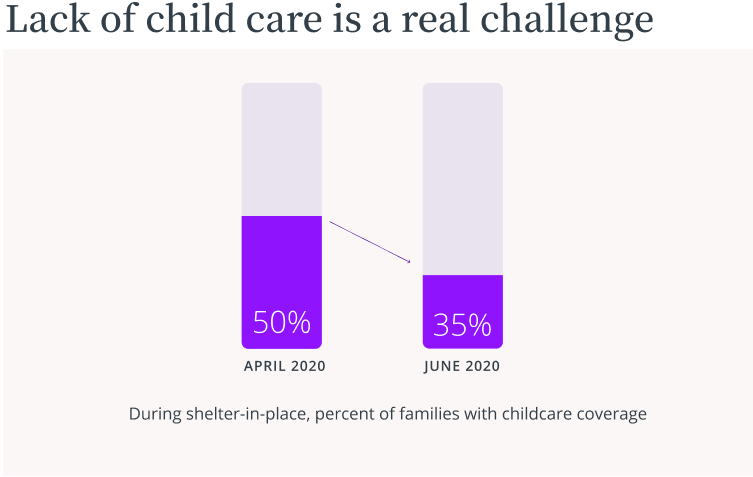
Childcare plans made by parents early on in shelter in place are yet to be realized:
- Family help doesn’t come to fruition: In April, 53% of families planned to move closer to family (or have family move closer to them). Additionally, 56% of respondents planned to continue trading off responsibilities with their partner. However, in June, only 28% had outside help from family.
- Challenges finding and arranging nanny and share-care solutions: In April, 16% of respondents said they were open to a nanny or a share-care model. By June, however, only 3% had formed a share-care, with some parents sharing the challenges of managing the search and logistics on their own.
“It took 4 weeks for us to find a nanny, and I had to take an extended leave from work to care for our two kids myself.” – Cleo member
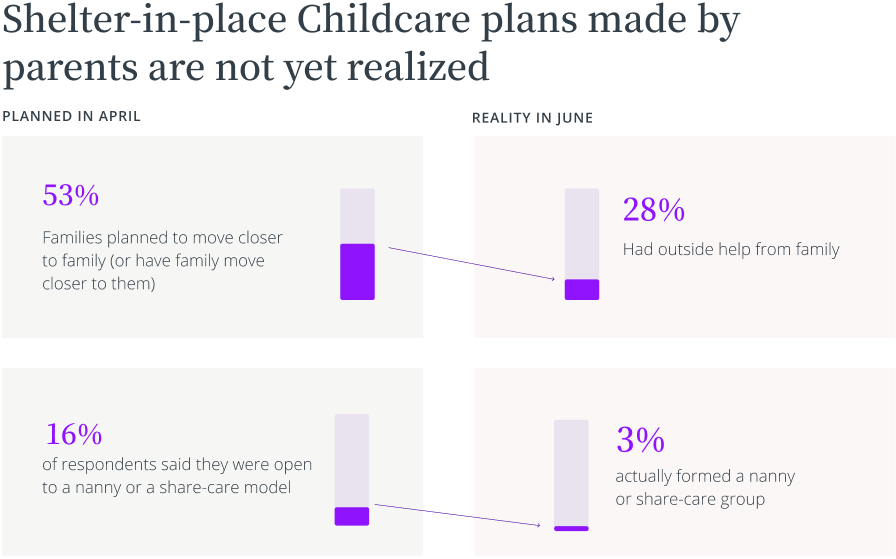
Continued uncertainty about COVID-19 and the future of work is impacting optimism and planning
As the months go by, working parents are losing optimism about returning to work, and the future workplace.
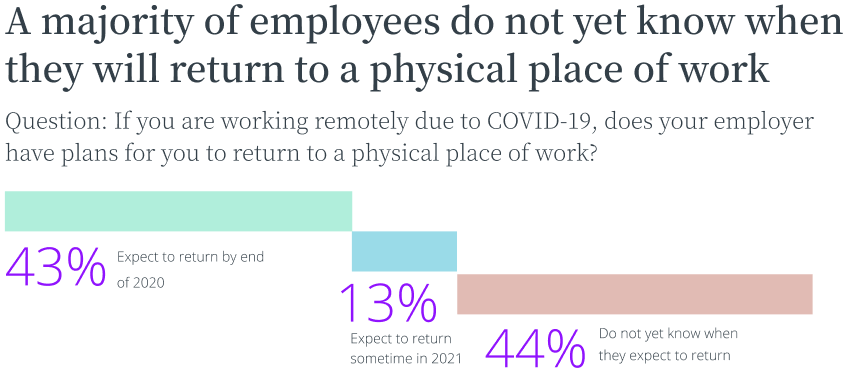
- Uncertainty about the future workplace: Of respondents who are currently working remotely due to COVID-19 safety concerns, only 43% expect to return to a physical place of work by the end of 2020. Another 13% expect to return to the office sometime in 2021, but the remaining 44% of respondents indicated that their employer had not yet shared plans about a return to a physical place of work yet, leaving them with uncertainty.
- Employees are feeling less productive: When asked how productive employees feel compared to before COVID-19, 30% of people feel less than 50% productive, compared to 25% in April.
- Delaying return to work post parental leave. The number of people planning to return to work after parental leave has remained consistent (94% in April and 92% in June); however, we found a decrease in the percentage of respondents who returned to work on time after parental leave: 83% in April and 72% in June.
- Plans to scale back or stop working after parental leave: Of those who had not yet returned to work after parental leave, respondents in June were four times more likely to plan to return on a part-time basis rather than full-time.
- Burnout and childcare challenges are as concerning as health and safety for parents thinking about return to offices: When asked about anticipated top challenges with returning to a physical workplace post-COVID, while respondents are concerned about health risks of returning to an office (55%), they are equally concerned about burnout from managing work and home (57%), and securing childcare (53%).
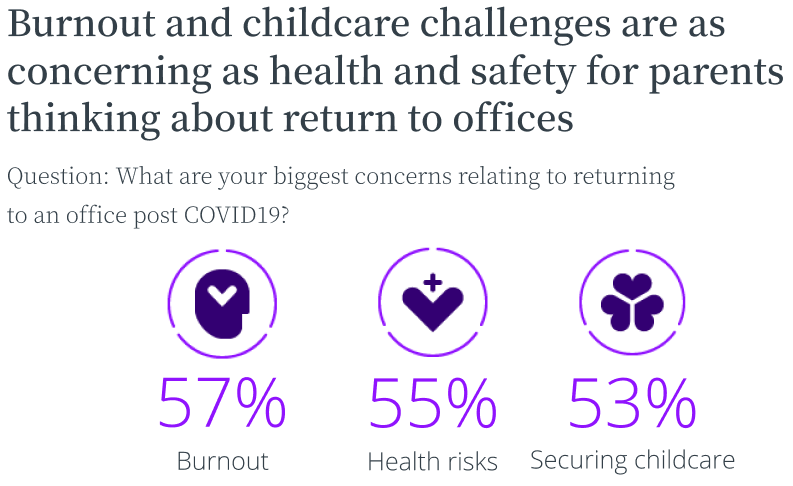
Parents – especially women – are struggling and dropping out of the workforce
Women continue to be disproportionately impacted by COVID-19 when it comes to childcare and household responsibilities. As a result, they’re leaving the workforce at a higher rate than their male counterparts.
- Women carrying the burden of childcare: In 95% of the surveyed households, the female parent/mother was doing at least 50% of the caregiving. In 56%, mothers indicated they were managing most or all of the caregiving.
- Emotional/mental wellness: As of June, women are 2.5x more likely than men to indicate that mental wellness is a challenge as a working parent. Nationally, employers are losing out on $225.5 billion a year due to lost productivity related to mental wellness alone(2).
- Leaving the workforce: In April, 20% said they were considering leaving the workforce. In June, 33% (1 in 3) of those surveyed report having at least one parent that has either left the workforce or dropped down to part-time, most likely the female parent/mother (70% of the time). This has a significant impact on companies’ efforts to retain female employees.
“Our baby was about to be one year when Covid-19 hit. I was on the verge of looking into childcare and starting to explore jobs and/or part-time work in March. I’m a graphic designer and left my role to extend my parental leave. Because my partner is working from home and we’re okay with a single salary, we decided that I’d continue with full-time parent-duty for the foreseeable future.” – Cleo member
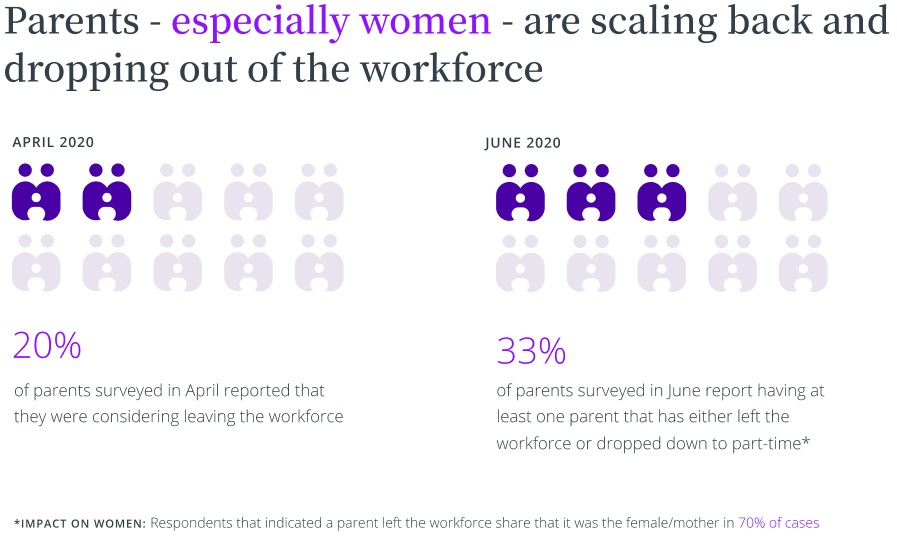
Take the first step to support working parents
COVID-19 has caused havoc for working families and many parents are struggling to balance between work and family – and as our recent data demonstrates, many have already made the difficult decision to scale back or depart from the workforce. Unfortunately, the federal government has done very little to address the childcare crisis. The onus is on employers to take action and enact the appropriate measures to ensure parents are supported through this unprecedented time. As the first step toward this goal, we encourage employers to reach out to their parent communities. Understanding your community’s needs, challenges, and current childcare situation will help inform actionable solutions.
Cleo’s support – making families that work, work
At Cleo, our customers’ parent communities are our first priority. Cleo has always prided itself on helping parents return to work. We supply employers with the tools and resources they need to help parents navigate changing demands so they can continue to thrive in the workplace – even (and especially) in times of crisis. In May, we partnered with UrbanSitter to introduce Cleo Care, a unique childcare solution designed to get parents back to work. Cleo Care helps parents find safe and secure childcare through vetted and personalized caregiver and co-op matching, as well as one-on-one coaching. If you’re interested in exploring Cleo Care for your parent community, drop us a line here.
From our most recent member survey, we are hearing that Cleo members are now even more likely to attribute Cleo’s services as helping parents return to work. When asked about agreement with the statement, “Support that I received from Cleo made me more confident in my ability to return to work.”, 84% of respondents agreed in April and 92% of respondents agreed in June.
As we face this sobering data on the additional burden placed on working parents from COVID-19 that seems to have no end in sight, we invite a new perspective from our employer clients and partners – to be inspired by the creativity and resiliency of the working parents in your population and to take a note from them in how they’ve already approached this time. As we consider new solutions, it’s clear the playbook doesn’t exist – and that what is required is new approaches and thinking. The Cleo team is committed to supporting our members as they navigate life as working parents in today’s context.
Methodology
For this report, we surveyed 136 respondents from 11 Cleo customers, representing a variety of industries including tech, finance, and food and beverage. Of the respondents, 71% were female and 29% were male. 40% of respondents had manager responsibilities and another 40% were junior or individual contributors. Respondents represented a range of household incomes. Approximately 25% of families had a household income of less than $100k/year and 33% of families had household income of over $250K/year. All respondents were more than four months post-birth, and had been enrolled in Cleo for at least three months.
(1) https://www.bls.gov/opub/ted/2017/employment-in-families-with-children-in-2016.htm
(2) Healthpayer Intelligence. “Employers Could See High Financial Returns for Mental Healthcare.” Sep 2018.
